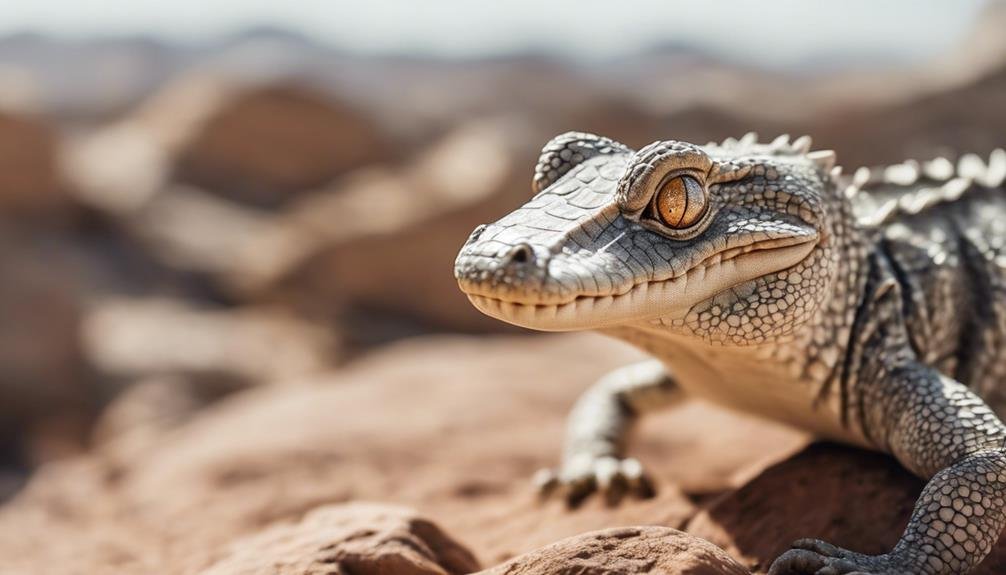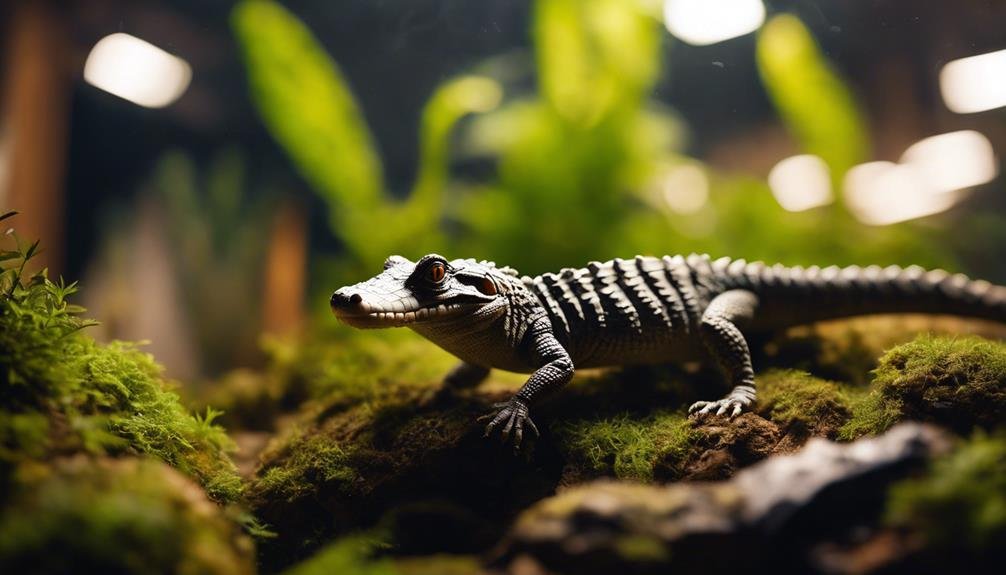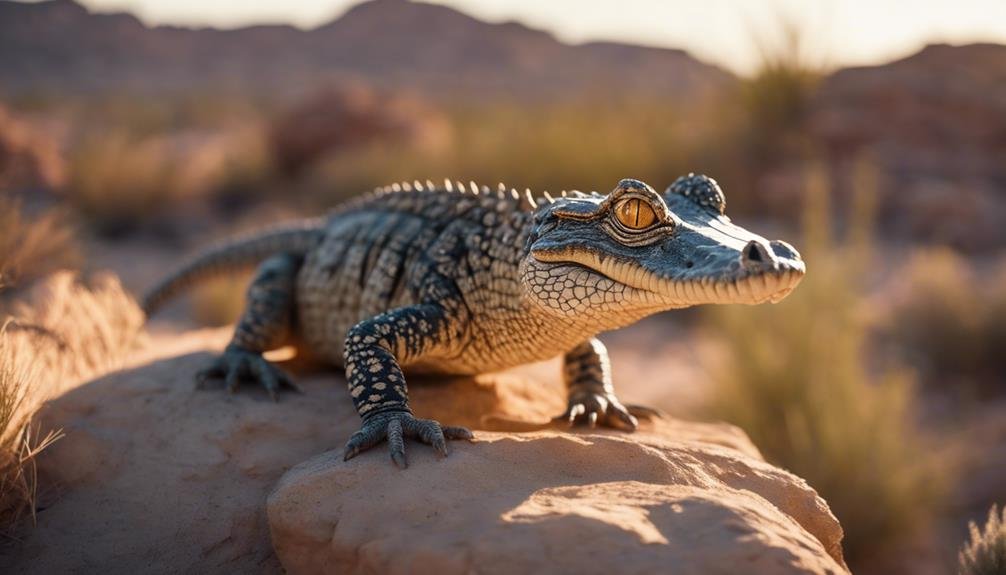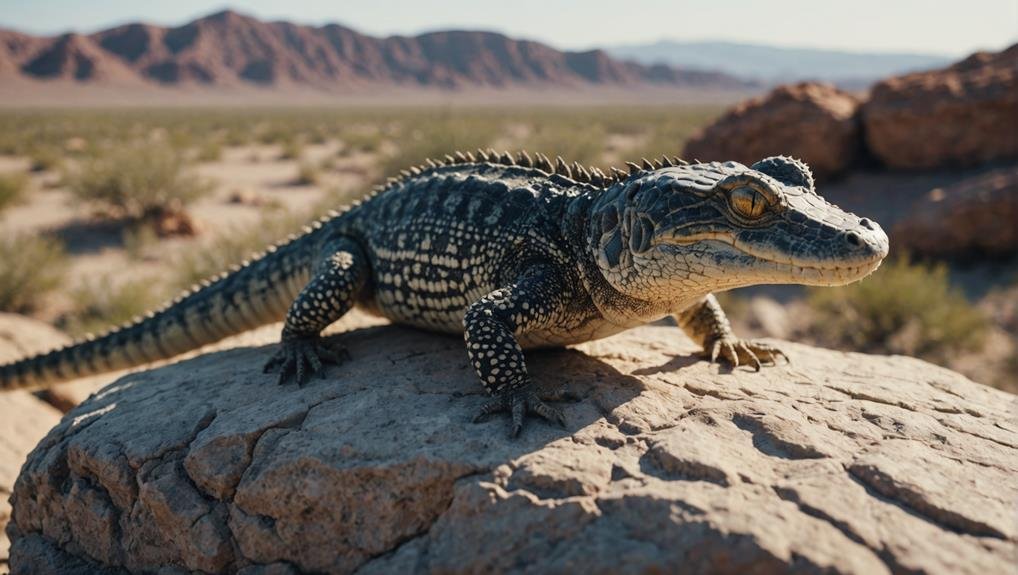When you think about fascinating reptiles, the Crocodile Gecko might come to mind with its rugged appearance and unique climbing abilities. Native to the Mediterranean, these geckos thrive in semi-arid, rocky landscapes, making them an interesting subject for anyone curious about reptilian adaptations. Their robust bodies and specialized adhesive toe-pads allow them to navigate challenging terrains effortlessly. But what’s truly intriguing is how these physical traits translate into their behavior and care requirements in a captive environment. Do you know what keeping a Crocodile Gecko healthy and content takes?
Key Takeaways
- Crocodile Geckos thrive in semi-arid rocky steppes and woodlands of the Mediterranean region.
- They have a robust body, flat head, and prominent conic tubercles on their back, legs, and tail.
- In captivity, they can live up to 10 years and grow up to 15 centimeters in length.
- These geckos are carnivorous, requiring a varied diet of live insects supplemented with calcium and multivitamins.
- Males should be housed separately to prevent aggression and territorial conflicts.
Habitat and Distribution


Crocodile Geckos thrive in the Mediterranean region’s semi-arid rocky steppes and woodlands. You’ll find them in rocky areas across the Mediterranean, from southern Europe to North Africa. Their distribution includes the Iberian Peninsula, southern France, coastal Italy, parts of Greece, Egypt, Libya, Tunisia, Algeria, and Morocco. Due to introductions, they even have isolated populations south of Western Sahara and regions like California.
It’s important to understand their environmental needs to replicate their natural habitat. These geckos prefer areas with plenty of rocks and crevices where they can hide and bask. They’re primarily nocturnal but may be active during sunny days, indicating their need for an appropriate temperature. You’ll need to provide a basking lamp and maintain the right temperature and humidity to keep them healthy.
In captivity, they mimic their natural semi-arid environment by using a substrate like a child’s play sand or vermiculite. Since they’re arboreal, make sure there’s plenty of vertical space for climbing. A thermostat will help maintain their habitat within the ideal temperature range. Understanding their natural habitat allows you to create a suitable living environment for these fascinating creatures.
Physical Characteristics
Have you ever wondered what gives these geckos their distinctive, almost prehistoric appearance? Crocodile Geckos boasts a robust body, making them appear sturdy and resilient. Their flat head is another striking feature, giving them a unique profile that’s hard to miss.
One of the most eye-catching aspects of these geckos is the prominent conic tubercles on their back, legs, and tail, which add to their rugged, ancient look.
You’ll also notice their large eyes, which are impossible to ignore. These eyes lack eyelids and have vertical pupils, enhancing their mysterious and enigmatic presence. Their obtuse mouth gives them a unique facial structure, distinguishing them from other gecko species.
Their fingers are fascinating, featuring large lateral growths and adherent division-less laminae on the bottom face. This specialized structure aids their climbing prowess, making them adept at traversing their environment.
Lifespan and Size


These fascinating reptiles can live up to 10 years in captivity, offering a lengthy commitment for any reptile enthusiast. Be prepared for this long-term relationship if you’re considering one as a pet. Their lifespan confirms their hardy nature and the care you provide.
Regarding size, adult crocodile geckos typically measure up to 15 centimeters (5.9 inches) in length, including their tail. This compact size makes them suitable for smaller enclosures, yet they still exhibit a striking presence. Their robust body is complemented by a flat head and prominent conic tubercles that adorn their back, legs, and tail. These features contribute to their unique appearance and offer a tactile texture that’s intriguing to observe.
One of their most alluring traits is their adhesive toe pads. These specialized pads allow them to easily cling to various surfaces, showcasing their remarkable climbing abilities. The large lateral growths and adherent division-less laminae on the bottom face of their fingers enhance their grip, making them skilled at exploring their environment.
With their obtuse mouth and big, lidless eyes featuring vertical pupils, crocodile geckos are truly a marvel to behold.
Diet and Nutrition
Ensuring a varied diet of small insects like crickets, moths, and beetles is vital for the health of your crocodile gecko. These carnivorous creatures thrive on a diet rich in live insects, which provides the necessary nutrition they need.
Incorporate a mix of crickets, moths, and beetles into their meals to keep their diet balanced and engaging. Avoid overfeeding high-fat insects like mealworms and waxworms, as these can lead to obesity and other health issues.
Supplementation is also essential. Dusting their food with calcium powder and multivitamins ensures they get the nutrients they might miss from their 1. This helps support their bone health and overall well-being.
Monitoring their feeding habits is key; crocodile geckos actively hunt moving prey, so live insects are a must to stimulate their instincts.
Housing Requirements


When setting up a home for your Crocodile Gecko, start with a 15-gallon enclosure to give them enough room to move and climb.
Guarantee you replicate their natural habitat by including rocky basking areas, crevices, and caves.
Using reptile heating pads, maintain the temperature between 78-85°F during the day and 70-75°F at night.
Enclosure Size Specifications
A 15-gallon tank provides ample room for a crocodile gecko to climb and hide. When considering the enclosure size, ensure the tank height allows for vertical space, as these geckos love exploring multiple levels. It would be best to incorporate rocky basking areas such as crevices and caves to mimic their natural habitat and support their natural behaviors.
Crocodile geckos are territorial creatures, so it’s important to house males separately to prevent aggression. The additional vertical space accommodates their climbing tendencies and helps reduce territorial disputes by offering multiple hiding spots and basking areas. This setup ensures each gecko has its own space to feel secure.
Creating a stimulating and comfortable environment is essential for your crocodile gecko’s well-being. Use a variety of decor and hiding places to keep the gecko engaged and stress-free. These elements are crucial in maintaining a healthy and happy pet. Remember, a well-structured enclosure with ample climbing and hiding opportunities will allow your crocodile gecko to thrive in captivity.
Ideal Temperature Range
Maintaining the right temperature range is just as important as providing ample climbing space and hiding spots for your crocodile gecko. The ideal temperature range during the day should be between 78 and 85 degrees Fahrenheit, while nighttime temperatures should drop to 70-75 degrees Fahrenheit. This fluctuation mimics their natural environment and guarantees their comfort.
Using reptile heating pads under the tank can help maintain these temperatures 24/7. Monitoring the temperature regularly with a reliable thermometer is essential to ensure it stays within the recommended range. Proper temperature regulation supports your gecko’s metabolism, aiding digestion and keeping them active and healthy.
To give you a clear picture, here’s a simple table outlining the ideal temperature ranges:
| Time of Day | Temperature Range (°F) |
|---|---|
| Daytime | 78-85 |
| Nighttime | 70-75 |
Health Issues
To keep your crocodile gecko healthy, it’s important to be aware of common health issues like parasites, mites, and infections. Parasites can cause symptoms such as weight loss and lack of appetite, while mites might lead to skin abnormalities. Infections often result in lethargy and other noticeable changes in behavior. Regular health checks by a reptile veterinarian are essential to detect and treat these problems early.
Maintaining a clean and well-kept habitat is vital to preventing these health issues. Ensure you provide proper nutrition, as a balanced diet boosts their immune system. The right temperature and humidity levels also play a significant role in keeping your gecko healthy. High humidity can foster fungal infections, while low moisture might result in dehydration and shedding problems.
If you notice any symptoms of illness, don’t delay seeking veterinary care. A reptile veterinarian can perform necessary tests to diagnose and treat the issue promptly. Early intervention often results in better outcomes, ensuring your crocodile gecko remains healthy and vibrant.
Regular monitoring and proper care are your best defenses against these common health problems.
Temperament and Behavior


Understanding your crocodile gecko‘s temperament and behavior is key to providing the best care and ensuring their well-being. Crocodile geckos are generally calm and non-aggressive creatures. They prefer observation over handling, making them great pets to watch rather than interact with directly. However, their quick movements can make it challenging to hold, so it’s best to limit handling to reduce stress.
One notable aspect of their behavior is their territorial nature, especially among males. If you have more than one male crocodile gecko, keeping them in separate enclosures is essential to avoid conflicts. Monitoring their environment and interactions will help you maintain a peaceful habitat.
Crocodile geckos might also exhibit hyperactivity, which is normal. This doesn’t necessarily indicate distress but rather their natural energy levels. Another important behavior is their tendency to hibernate for 6-8 weeks during colder months. Providing suitable conditions for hibernation is vital for their health.
Monitor your gecko for signs of stress, illness, or shedding issues. Regular monitoring will help you catch any problems early and maintain their well-being.
Conclusion
When caring for a crocodile gecko, you’ll find their unique needs and behaviors intriguing. You’ll guarantee they thrive by providing a habitat that mimics their natural rocky environment and a diet of live insects.
With proper care, these enthralling reptiles can live up to 10 years. Understanding their physical characteristics and health needs will help keep them healthy and happy.
Embrace the adventure of owning a Crocodile Gecko, and you’ll be rewarded with an extraordinary pet.


